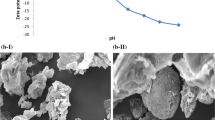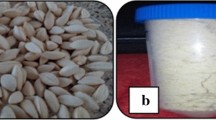Abstract
The study is aimed to determine Pb (II) biosorption from synthetic wastewaters using natural and modified tea factory waste as biosorbent material. This process is carried out with this waste matter, which is found in large quantities, so cheap and has high metal adsorption ability. The sorption kinetic studies were determined as variations of initial pH value, particle size, initial Pb (II) and tea factory waste concentrations, stirring speed and temperature. Biosorption reached the equilibrium in 15 min. Zeta potential values of the biosorbent were defined in the range of pH 2 to 4. The adsorption isotherm models give the experimental values, and the thermodynamic characteristics of the patterns generally give insight about the sorption mechanism depending on the surface characteristics and affinity of the biosorbent. The biosorption mechanism was searched considering to Freundlich, Langmuir, BET and Temkin isotherm model, and the experimental adsorption values were conformed to Freundlich adsorption model. The optimum experimental conditions were investigated as pH 3.5, particle size of 0.125–0.25 mm, stirring speed of 200 rpm, biosorbent concentration of 7 g L−1 and 25 °C. In these conditions, the highest efficiency of biosorption was obtained as 94.07% and after the activating process the efficiency was reached to 97.73% at 70 mg L−1. The maximum Pb (II) removal capacity of raw tea factory waste was found to be 22.111 mg g−1 at 200 mg L−1. The biosorption kinetics has complied with the pseudo-second-order model. Thermodynamic studies stated that this biosorption phenomenon was an endothermic process.






Similar content being viewed by others
References
Ahmaruzzaman M, Gupta VK (2011) Rice husk and its ash as low-cost adsorbents in water and wastewater treatment. Ind Eng Chem Res 50:13589–13613
Amin M, Alazba A, Shafiq M (2019) Application of biochar derived from date palm biomass for removal of lead and copper ions in a batch reactor: kinetics and isotherm scrutiny. Chem Phys Lett 722:64–73
Aryal M, Ziagova MG, Liakopoulou-Kyriakides M (2012) Cu (II) biosorption and competitive studies in multi-ions aqueous systems by Arthrobacter sp. Sphe3 and Bacillus sphaericus cells: equillibrium and thermodynamic studies Water. Air Soil Pollut 223:5119–5130
Bhattacharyya KG, Gupta SS (2008) Adsorption of a few heavy metals on natural and modified kaolinite and montmorillonite: a review. Adv Colloid Interface Sci 140(2):114–131
Blázquez G, Calero M, Ronda A, Tenorio G, Martín-Lara M (2014) Study of kinetics in the biosorption of lead onto native and chemically treated olive stone. J Ind Eng Chem 20:2754–2760
Dundar M, Nuhoglu C, Nuhoglu Y (2008) Biosorption of Cu (II) ions onto the litter of natural trembling poplar forest. J Hazard Mater 151:86–95
Feisther VA, Scherer Filho J, Hackbarth FV, Mayer DA, de Souza AAU, de Souza SMGU (2019) Raw leaves and leaf residues from the extraction of essential oils as biosorbents for metal removal. J Environ Chem Eng 7:103047
Fernández-González R, Martín-Lara MA, Iáñez Rodríguez I, Calero M (2018) Removal of heavy metals from acid mining effluents by hydrolyzed olive cake. Bioresour Technol 268:169–175
Giannakopoulos E, Christoforidis K, Tsipis A, Jerzykiewicz M, Deligiannakis Y (2005) Influence of Pb (II) on the radical properties of humic substances and model compounds. J Phys Chem A 109:2223–2232
Ho Y, Ng J, McKay G (2000) Kinetics of pollutant sorption by biosorbents. Sep Purif Methods 29:189–232
Hunter RJ (2013) Zeta potential in colloid science: principles and applications, vol 2. Academic press, Cambridge
Jerzykiewicz M, Drozd J, Jezierski A (1999) Organic radicals and paramagnetic metal complexes in municipal solid waste composts. An EPR Chem Study Chemosphere 39:253–268
Ji Y, Gao H, Sun J, Cai F (2011) Experimental probation on the binding kinetics and thermodynamics of Au (III) onto Bacillus subtilis. Chem Eng J 172:122–128
Karatas M (2012) Removal of Pb (II) from water by natural zeolitic tuff: kinetics and thermodynamics. J Hazard Mater 199:383–389
Kılıc M, Keskin M, Mazlum S, Mazlum N (2008) Effect of conditioning for Pb (II) and Hg (II) biosorption on waste activated sludge. Chem Eng Process Process Intensif 47:31–40
Malkoc E (2006) Ni (II) removal from aqueous solutions using cone biomass of Thuja orientalis. J Hazard Mater 137:899–908
Malkoc E, Nuhoglu Y (2006) Fixed bed studies for the sorption of chromium (VI) onto tea factory waste. Chem Eng Sci 61:4363–4372
Malkoc E, Nuhoglu Y (2007) Potential of tea factory waste for chromium (VI) removal from aqueous solutions: thermodynamic and kinetic studies. Sep Purif Technol 54:291–298
Manawi Y, McKay G, Ismail N, Fard AK, Kochkodan V, Atieh MA (2018) Enhancing lead removal from water by complex-assisted filtration with acacia gum. Chem Eng J 352:828–836
Miretzky P, Cirelli AF (2010) Cr (VI) and Cr (III) removal from aqueous solution by raw and modified lignocellulosic materials: a review. J Hazard Mater 180:1–19
Petrović M, Šoštarić T, Stojanović M, Milojković J, Mihajlović M, Stanojević M, Stanković S (2016) Removal of Pb2+ ions by raw corn silk (Zea mays L.) as a novel biosorbent. J Taiwan Inst Chem Eng 58:407–416
Qaiser S, Saleemi AR, Umar M (2009) Biosorption of lead from aqueous solution by Ficus religiosa leaves: batch and column study. J Hazard Mater 166:998–1005
Reddy MCS, Kumar ER, Rao BA (2014) Optical and ESR studies of lead antimony borate glasses doped with V2O5 international. J Sci Eng Res 5:232–237
Ronda A, Martín-Lara MA, Calero M, Blázquez G (2013) Analysis of the kinetics of lead biosorption using native and chemically treated olive tree pruning. Ecol Eng 58:278–285
Sathish T, Vinithkumar N, Dharani G, Kirubagaran R (2015) Efficacy of mangrove leaf powder for bioremediation of chromium (VI) from aqueous solutions: kinetic and thermodynamic evaluation. Appl Water Sci 5:153–160
Say R, Denizli A, Arıca MY (2001) Biosorption of cadmium (II), lead (II) and copper (II) with the filamentous fungus Phanerochaete chrysosporium. Bioresour Technol 76:67–70
Svecova L, Spanelova M, Kubal M, Guibal E (2006) Cadmium, lead and mercury biosorption on waste fungal biomass issued from fermentation industry. I. Equilibrium studies. Sep Purif Technol 52(1):142–153
Southichak B, Nakano K, Nomura M, Chiba N, Nishimura O (2006) Phragmites australis: A novel biosorbent for the removal of heavy metals from aqueous solution. Water Res 40(12):2295–2302
Suksabye P, Nakajima A, Thiravetyan P, Baba Y, Nakbanpote W (2009) Mechanism of Cr (VI) adsorption by coir pith studied by ESR and adsorption kinetic. J Hazard Mater 161:1103–1108
Vázquez G, Calvo M, Freire MS, González-Alvarez J, Antorrena G (2009) Chestnut shell as heavy metal adsorbent: optimization study of lead, copper and zinc cations removal. J Hazard Mater 172:1402–1414
Weber WJ (1972) Physiochemical processes for water quality control
Yu B, Zhang Y, Shukla A, Shukla SS, Dorris KL (2001) The removal of heavy metals from aqueous solutions by sawdust adsorption-removal of lead and comparison of its adsorption with copper. J Hazard Mater 84(1):83–94
Yuvaraja G, Pang Y, Chen DY, Kong LJ, Mehmood S, Subbaiah MV, Reddy GM (2019) Modification of chitosan macromolecule and its mechanism for the removal of Pb (II) ions from aqueous environment. Int J Biol Macromol 136:177–188
Zein R, Suhaili R, Earnestly F, Munaf E (2010) Removal of Pb (II), Cd (II) and Co (II) from aqueous solution using Garcinia mangostana L. fruit shell. J Hazard Mater 181:52–56
Acknowledgements
The authors wish to thank the Department of Environmental Engineering of the Faculty of Engineering at Atatürk University and all the valued employees at General Directorate of Tea Enterprises (ÇAYKUR).
Author information
Authors and Affiliations
Corresponding author
Additional information
Editorial responsibility: Fatih ŞEN.
Rights and permissions
About this article
Cite this article
Nuhoğlu, Y., Ekmekyapar Kul, Z., Kul, S. et al. Pb (II) biosorption from the aqueous solutions by raw and modified tea factory waste (TFW). Int. J. Environ. Sci. Technol. 18, 2975–2986 (2021). https://doi.org/10.1007/s13762-020-03038-8
Received:
Revised:
Accepted:
Published:
Issue Date:
DOI: https://doi.org/10.1007/s13762-020-03038-8




